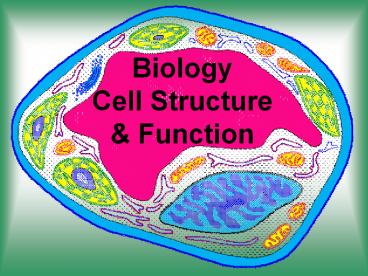Biology Cell Structure - PowerPoint PPT Presentation
1 / 26
Title:
Biology Cell Structure
Description:
... occurs Has its own DNA and a double membrane Mitochondria Chloroplast Lysosome Spherical organelle where digestion occurs Remove ... to make its own food ... – PowerPoint PPT presentation
Number of Views:67
Avg rating:3.0/5.0
Title: Biology Cell Structure
1
BiologyCell Structure Function
2
What is a cell?
- The smallest unit that is capable of performing
life functions. - After observing many cells, scientists came up
with the cell theory - All living things are made of 1 or more cells.
- Cells are the basic units of structure and
function in organisms. - All cells come from existing cells.
3
Cell Size
- To function efficiently, cells must be small.
Why? - If a cell is the shape of a cube and has 1 mm
sides, calculate the surface area of the cube
using the formula 6S2. Also, calculate the
volume using the formula S3. What is the surface
area to volume ratio? - Do the same calculations for a cell having 2 mm
sides. - What happens to the SA/volume ratio as the cell
gets bigger? Why is this bad?
4
(No Transcript)
5
2 Main Cell Types
- Prokaryotic
- Eukaryotic
- Originated approximately 1.5 billion years ago
- 2-100µm typical plant/animal cell is 10-50µm
- Organized- Have a nucleus and other organelles
(structures that carry out specific functions for
the cell) - DNA is in the form of chromosomes
- Example- animal and plant cells
- Originated approximately 3.5 billion years ago
- 0.5- 2µm (µ is the symbol for micro which means
1/1,000,000 - Simple- no nucleus nor other special compartments
- Single, circular DNA molecule
- Example- bacterium
6
Prokaryotic Bacterial Cell
7
Eukaryotic Plant Cell
8
Eukaryotic Animal Cell
9
Characteristics of ALL Cells
- All pro and eukaryotic cells have the following
- Cell membrane- An outer boundary which is also
called the plasma membrane - Cytoplasm- The interior of a cell just the
liquid is called cytosol. - Cytoskeleton (microtubules/microfilaments)-
Protein filaments (thread-like structures) that
are important in cell movement, shape and
division - Ribosomes- Structures that do not have a membrane
and make proteins - DNA- hereditary information
10
Eukaryotic Organelles
11
Organelles that Surround the Cell
- Cell membrane- Selects what can enter and leave
the cell. More about this later! - Cell wall
- Most commonly found in plant cells and bacteria-
NOT IN ANIMAL CELLS! - Surrounds the cell membrane and provides
structure and support - Made of cellulose- long carbohydrate chain
- Cilia- Short, numerous hairs that move the cell
and/or substances outside the cell - What human cells have cilia?
12
- Flagella- Long tail(s) that moves the cell and/or
substances outside the cell - Both cilia and flagella are made of protein
filaments like the cytoskeleton. - What human cell has a flagellum?
13
Organelles inside the cell
- Nucleus
- Directs the cells activities
- Houses DNA
- Houses the nucleolus
- where ribosomes are made
- Surrounded by a double membrane called the
nuclear envelope - controls what exits the nucleus like ribosomes
and RNA - has openings called nuclear pores
14
- Endoplasmic reticulum
- System of membranes that move proteins around
inside the cell- intracellular highway - Can be smooth or rough
- rough has ribosomes attached to it and smooth
does not - ribosomes can also be found in the cytosol
- Golgi apparatus
- Flattened sacs
- Processes proteins into vesicles (membrane bound
sacs)
15
- Mitochondria
- Produces ATP- form of energy that can be used by
the cell. What cells of the body have lots of
mitochondria? - Has a double membrane
- Outer membrane is smooth and the inner membrane
(cristae) is folded. - Has its own DNA
- Chloroplast
- In plants, some protists and some bacteria- NOT
IN ANIMAL CELLS! - Where photosynthesis occurs
- Has its own DNA and a double membrane
16
Mitochondria
17
Chloroplast
18
- Lysosome
- Spherical organelle where digestion occurs
- Remove the web between fingers of a fetus
- Usually in animal cells
- Central Vacuole
- Large
- Stores water, nutrients and waste
- Only in plant cells
- Animal cells have vacuoles- but not central
vacuoles
19
(No Transcript)
20
(No Transcript)
21
Typical Animal Cell
http//web.jjay.cuny.edu/acarpi/NSC/images/cell.g
if
22
Typical Plant Cell
23
How do animal and plant cells differ?
- Animal
- Plant
- Spherical
- Might have flagella or cilia
- Rectangular
- Have a cell wall
- Have chloroplasts
- Have a central vacuole
24
Evolution of the Eukaryotic Cell
- A possible explanation for how eukaryotic cells
came into existence is the endosymbiotic theory. - Symbiosis is a relationship between organisms
where every member benefits. - The endosymbiotic theory states that chloroplasts
and mitochondria were once prokaryotic bacteria.
They entered a larger prokaryotic cell and all
parties benefited. - The chloroplast and mitochondria got extra
protection and the larger cell developed the
ability to make its own food and energy.
25
Evidence of the endosymbiotic theory
- Both chloroplasts and mitochondria have their own
circular DNA (like prokaryotic cells). - Both chloroplasts and mitochondria have a double
membrane. - Mitochondria are approximately the size of
bacteria.
26
Game to Review Organelles































